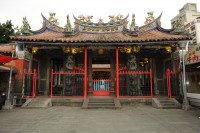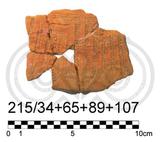|
Clashes in Monga a Hundred Years Ago—Chronicles of the Gang Leaders of History |
|
 In Taiwan there is a saying, “Tainan first, Lugang second, Monga third.” This phrase states that of the three major cities in Qing Dynasty in Taiwan, Monga (now Wanhua District, Taipei) was third. Monga’s proximity to the Tamsui river allowed its business activities to gradually flourish. The name “Monga,” which originated from “Moungar/Mankah” meaning canoe in the language of the local Pepo people, clearly suggests Monga was a place known for convenient shipping transportation and prosperous business development at the time.
In Taiwan there is a saying, “Tainan first, Lugang second, Monga third.” This phrase states that of the three major cities in Qing Dynasty in Taiwan, Monga (now Wanhua District, Taipei) was third. Monga’s proximity to the Tamsui river allowed its business activities to gradually flourish. The name “Monga,” which originated from “Moungar/Mankah” meaning canoe in the language of the local Pepo people, clearly suggests Monga was a place known for convenient shipping transportation and prosperous business development at the time.
|
|
Read more...
|
|
 Folk acrobatics have always been the most anticipated performance at the Taiwanese National Day Celebration every year. In the performances, agile acrobats execute fantastic feats, such as unicycling, jumping through flaming hoops, plate spinning, jujitsu, handstands, and human pyramids. The performers always scare the audience a bit by making the pyramid wobble on the brink of collapse before executing perfect flips in the air, landing on the ground to receive boisterous applause. Finally, the performance always ends with the biggest human pyramid, the Jin Yu Man Tang (a Chinese idiom referring to a prosperous household), bringing the cosmopolitan affair to a mighty climax.
Folk acrobatics have always been the most anticipated performance at the Taiwanese National Day Celebration every year. In the performances, agile acrobats execute fantastic feats, such as unicycling, jumping through flaming hoops, plate spinning, jujitsu, handstands, and human pyramids. The performers always scare the audience a bit by making the pyramid wobble on the brink of collapse before executing perfect flips in the air, landing on the ground to receive boisterous applause. Finally, the performance always ends with the biggest human pyramid, the Jin Yu Man Tang (a Chinese idiom referring to a prosperous household), bringing the cosmopolitan affair to a mighty climax.
|
|
Read more...
|
|
Nourish the Body, Nourish the Soul–Four Seasons Kitchen |
|
 The 24 solar terms are an ancient set of calendar terms that are still used today for guidance on coordinating agricultural activities with climactic changes. “Qingming” falls on the fifth solar term of the year, each year comprising a total of 24 terms. Its name denotes a time when flowers bloom and plants sprout new leaves to create clear (qing) and bright (ming) scenery in spring. The solar term Qingming is often associated with the Qingming Festival, also known as Tomb Sweeping Day.
The 24 solar terms are an ancient set of calendar terms that are still used today for guidance on coordinating agricultural activities with climactic changes. “Qingming” falls on the fifth solar term of the year, each year comprising a total of 24 terms. Its name denotes a time when flowers bloom and plants sprout new leaves to create clear (qing) and bright (ming) scenery in spring. The solar term Qingming is often associated with the Qingming Festival, also known as Tomb Sweeping Day.
|
|
Read more...
|
|
Just forgetting to go home──Tadao Kano, a naturalist who stayed in the southern lands forever |
|
 Motivated by his passion for insects since childhood, Tadao Kano (1906-1945?), after graduating from junior high school, chose to enroll at the Taiwan Governor-General Office High School that launched student recruitment for the first time. Taiwan, the southern island full of unknown species for him, thus became a spectacular stage for his life.
Motivated by his passion for insects since childhood, Tadao Kano (1906-1945?), after graduating from junior high school, chose to enroll at the Taiwan Governor-General Office High School that launched student recruitment for the first time. Taiwan, the southern island full of unknown species for him, thus became a spectacular stage for his life.
|
|
Read more...
|
|
The Prehistoric Pottery of Lapita Culture in the Pacific |
|
 The Lapita Cultural Complex, according to archaeological evidence, appeared on various islands scattered over a large expanse of sea, extending westward to the Bismarck Archipelago in Papua New Guinea, the Solomon Islands, the Vanuatu Islands and New Caledonia, and eastward to Fiji, Tonga and Samoa. The Lapita Cultural Complex was dated as far back as 3,600 to 2,500 years ago. Pottery decorated with fine dentate stamps is a major part of the Lapita Cultural Complex, which also includes stone tools, shell artifacts, and objects of barter. From the archaeological finding, one can infer that the subsistence economies of these islands were most likely based on marine resources, and the life style was very likely related to agriculture. The Lapita Cultural Complex, according to archaeological evidence, appeared on various islands scattered over a large expanse of sea, extending westward to the Bismarck Archipelago in Papua New Guinea, the Solomon Islands, the Vanuatu Islands and New Caledonia, and eastward to Fiji, Tonga and Samoa. The Lapita Cultural Complex was dated as far back as 3,600 to 2,500 years ago. Pottery decorated with fine dentate stamps is a major part of the Lapita Cultural Complex, which also includes stone tools, shell artifacts, and objects of barter. From the archaeological finding, one can infer that the subsistence economies of these islands were most likely based on marine resources, and the life style was very likely related to agriculture.
|
|
Read more...
|
|
|
William Campbell—A Pioneer in Educating the Visually Impaired Who Won the Heart of the People Through His Appetite |
|
 After taking up theological studies in Glasgow, Scotland, where he was born, William Campbell (1841-1921) was instructed by the Presbyterian Church of England to undertake missionary work in Taiwan. At that time, understanding of the Christian faith in Taiwan was limited, which posed many obstacles for the dissemination of sermons by the missionaries. In the Bai-shui River Episode (1875), the church in which Campbell resided was set fire to and severely damaged. A monument in remembrance of the incident was erected outside the Bai-shui Church in Chiayi.
After taking up theological studies in Glasgow, Scotland, where he was born, William Campbell (1841-1921) was instructed by the Presbyterian Church of England to undertake missionary work in Taiwan. At that time, understanding of the Christian faith in Taiwan was limited, which posed many obstacles for the dissemination of sermons by the missionaries. In the Bai-shui River Episode (1875), the church in which Campbell resided was set fire to and severely damaged. A monument in remembrance of the incident was erected outside the Bai-shui Church in Chiayi.
|
|
Read more...
|
|
|
<< Start < Prev 1 2 3 4 5 6 7 8 9 10 Next > End >>
|
|
Page 6 of 17 |